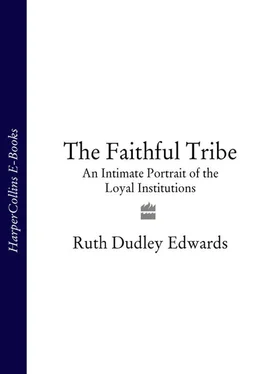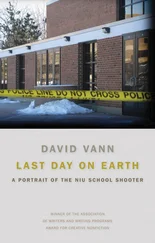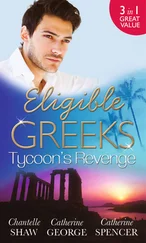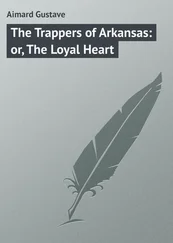Billy Bloomer’s ambition was to be a lecturer, and although his training was interrupted by a serious operation, he gained his lecturer’s certificate in 1990. To mark the event, members of the class presented him with an inscribed ‘Spirit of ‘88 Bible which Billy carries proudly to church,’ continued the anonymous article in a Sandy Row Orange publication:
The real test for any lecturer occurs when he gives the lecture and address in his own private lodge for the first time.
Billy’s style and delivery so impressed the members of [LOL] 1064 they gave him a standing ovation. Not surprisingly, the lodge elected him to the office of First Lecturer, and Billy’s greatest pleasure is to take the floor and give instruction to new members of the Order.
The difficulties that William has overcome in his short life have been many, but the smiling face with which he greets his brethren helps to put one’s own problems into perspective …
‘Wee Wullie’ is looking forward to parading to the ‘field’ on the Twelfth for, as he says, ‘while others complain of sore feet, it’s just a pushover for me’.
To the eye of the 1990s, that might sound patronizing, but to William Bloomer and his brethren, it is simply an acknowledgement of the fellowship and the respect the Ulster Protestant feels for those who know how to endure suffering without bitterness.
The Royal Arch Purple and the Royal Black Preceptories
When you have been initiated as an Orangeman, you have taken the Orange degree. You then go through a similar test, usually within six months to a year, to acquire the Purple. The history and nature of degrees are of absorbing interest to many Orangemen and of very little interest to anyone else. They take their meaning of the word from the question of Isaiah in 2 Kings 20.9: ‘Shall the shadow go forth ten degrees or go back ten degrees?’ Degrees are therefore a measure of spiritual movement and are intended to deepen biblical knowledge.
Traditionally, there has been a difference between those who want to keep ritual to a minimum and those who thoroughly enjoy it. Some Orange leaders banned rituals and degrees borrowed from Freemasonry, but those had been greatly enjoyed by simple people who wanted some mystery in their lives. The Royal Arch Purple Order, which these days is tolerated by Grand Lodge, was founded to preserve an outlawed degree. It prides itself ‘on having a legitimate and historical claim to be the inheritors of the [Orange Order’s] original initiation rituals and ceremonies’. The Grand Black Chapter of the Royal Black Institution traces its origins back to the Knights Hospitallers and the Knights of Malta; it came into existence shortly after the Orange Order. Many people join because they feel it offers a spiritual dimension.
‘The Black would have to be more scriptural and more Bible-based, with Bible-teaching and that,’ said a Mourne Blackman. ‘Basically our Black meeting was like a gospel meeting. The leaders of the preceptory were all Christian fellows. The degrees would have been taught in that way. Degrees are really the drama of asking the questions behind the story. So that would occupy most of the time. My main reason for being in the institution was religious.’
‘I joined the Black because I liked the parade in Scarva,’ said one member. ‘It was very well disciplined and well controlled, with good bands, good music. And because I was told all along that the Black institution was actually the main institution that taught the biblical principles of the Protestant faith in the various degrees that you went through. And there was more scope for teaching within it and getting our own people to have a greater knowledge of what our faith is about. The Orange wouldn’t have that capacity.’
‘The Black is a very graceful, decorous, sedate organization,’ another Blackman explained. ‘The Grand Master is in his flowing robes and the Grand Black Chapter has a procession into the chapter room with the mace being borne in front of him.’
A mutual Orange friend who has never been attracted by the Black was listening keenly. ‘It’s a bit popish, isn’t it?’ he commented, not very seriously, but with some truth. ‘No, it’s ceremonial.’ ‘Popery. Sheer undiluted popery.’ ‘Listen to Oliver Cromwell,’ laughed the Blackman. And we fell into an absorbing discussion as to whether it was permissible to have a cross in a church and whether they thought Cromwell had been right to try to destroy all religious statuary.
Chapters of the Royal Arch Purple meet primarily to initiate Orangemen into the Royal Arch Purple degree in a ritual more elaborate than the Orange and the Purple and involving a lot of ‘travel’. Black preceptories offer ten elaborate degrees: Royal Black, Royal Scarlet, Royal Mark, Apron and Blue, Royal White, Royal Green, Royal Gold, Star and Garter, Crimson Arrow, Link and Chain, and Red Cross. Where Orangemen and members of the Royal Arch Purple call each other Brother (and write to each other as Bro.), Blackmen call each other Sir Knight. However outsiders may view all this, there is no doubting its importance to many of their members. ‘I gained great spiritual depth from going through the degrees,’ said one of my friends. ‘The ritual, the tests, the questions and answers, the drama, brought the Bible stories they were based on home to me. And the morals drawn were right.’
‘It depends on how you’re able to receive it,’ said a Black lecturer. ‘You only go a wee bit at a time. There’s a lesson in every degree and the greatest lesson that I can find from any of them is where the children of Israel on the other side of Jordan built the altar and then the bigger part of their brethren saw it and thought they were worshipping false gods. And they condemned their brethren.
‘And then they found out the truth – that they had built it to God and that their brethren were true Israelites, but that they had condemned them without one particle of evidence being produced. The lesson I learned I teach candidates is if you made up your mind, saying you’ve had a mouthful of this boy and you were just going to give him a hiding the night, just stop and think and don’t make a hasty judgment on him. Wait. And tomorrow when you waken you’ll have a different picture. I explain that to them.’
‘The acting out of Bible stories and the signs and emblems and all that are rather like mystery plays,’ points out an historically-minded Blackman. ‘They helped illiterate people like many of our early members to remember scriptural truths. When properly performed by a good lecturer, these stories and truths can leave an imprint. And the tradition remains a good one. Many of our people are not book-minded, but they like and can relate to imagery.’
The role of the lecturer is crucial. They are part of an oral tradition: they explain the stories, teach degree candidates their responses and play a crucial part in the ceremonies. It is because they believe that the degree system helps people lead a better life, that so many of them give up an enormous amount of their time to pass on the oral tradition to their brethren.
Read with imagination (and with the information on Arch Purple and Black emblems given in the next chapter), ‘The Black Man’s Dream’, a song written around 1795, gives a good indication of what is involved in the ‘travel’.
One night I thought a vision brought
Me to a spacious plain,
Whereon its centre stood a mount,
Whose top I wished to gain;
Orange, blue, and purple, too,
Were given me to wear,
And for to see the mystery
They did me thus prepare.
My guide a pack placed on my back –
With pillars of an arch –
A staff and scrip placed in my hand,
Читать дальше












